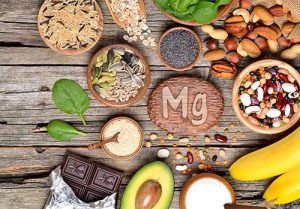
Image By craevschii
Magnesium and vitamin D go hand and hand. Vitamin D deficiency is a prevalent problem in the U.S., especially during the winter months. Many people will find themselves supplementing Vitamin D to correct this. However, an oftentimes missed counterpart is magnesium. Magnesium is necessary to activate Vitamin D within the body and experts recommend supplementing the two together. Interestingly, sometimes it is actually low magnesium levels driving the vitamin D deficiency.
Magnesium
Magnesium is a mineral commonly found in foods such as leafy green vegetables, nuts, avocado, dark chocolate, and Salmon. Magnesium can also be absorbed through the skin by way of Epson salt (magnesium sulfate). In the U.S. up to 80% of the population is not getting enough magnesium from their daily diet for optimal function. Keep in mind that there is a difference between not being deficient and having optimal levels. There are many possible factors contributing to this problem such as alcohol consumption, taking certain medications, increased consumption of processed foods which increases the need for magnesium, and lack of magnesium-rich foods in the diet. Supplementation may be necessary to achieve optimum levels.
Vitamin D
While “vitamin” is in the name, vitamin D is actually a fat-soluble hormone created in the body in response to exposure to UV light rays. This hormone is a vital component of many different functions in the body. Immune system strength, cardiovascular health, cancer prevention, and bone strength are just a few of the things dependent on vitamin D for optimization.
Working in Tandem
Magnesium appears to have a regulating effect on vitamin D by allowing it to rise when levels are low and by lowering it when levels are high. As many other vitamins and minerals do, the two work in conjunction with each other. Vitamin D does not become bioavailable in the body without magnesium and instead vitamin D will become stored in the tissue until magnesium is available to activate it. Because of this phenomenon, people who are supplementing vitamin D may not see an improvement in their levels until their magnesium levels are also addressed.
Optimize
Aside from supplementation, there are a few ways to go about increasing your magnesium intake every day naturally. Address your diet and assess how many processed or sugary foods you are eating. It may be time to start incorporating more whole foods into your diet instead. Consider adding more magnesium-rich foods into your diet. In addition to diet, absorption through the skin can be increased by taking regular baths with Epson salt (magnesium sulfate) or to use a daily topical magnesium spray. Remember to talk to your doctor about the right amount of supplementation for you.
Got Medicare Questions?
We hope that this information on the connection between magnesium and vitamin D is useful to you.
Let us help you answer your questions so that you can get back to the activities that you enjoy the most.
Call (888) 446-9157, click here to get an INSTANT QUOTE, or leave a comment below!
See our other websites:

